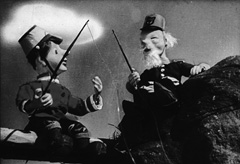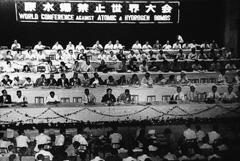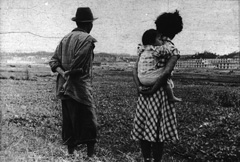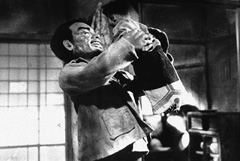The Magic Lantern Protests
Reading: Okada Hidenori, Washitani Hana
Piano: Yanashita Mie
Cooperation: Kobe Planet Film Archive, Ueno Akashi, Puppet Theatre PUK
Co-presented by: JSPS, Grant Number 15K02188 “Research concerning the revival and original development of Japanese Showa Era gento (magic lantern) culture.” (Principal researcher: Washitani Hana)
The use of the gento (or traditional Japanese “magic lantern,” developed for projecting still images) was revived out of necessity during the Second World War for national propaganda and military education purposes. During the 1950s, it also became an established medium for social movements seeking to raise awareness of and agitate around the problems facing post-war Japanese society. This program will feature in particular gento projections of four gento works produced in conjunction with the anti-war and labor movements, which were widely popular in the 1950s. We will try to convey the protests and demands that were entrusted to this extremely versatile medium.
 Wild Roses
Wild Roses
(Nobara)- 1952
Author: Ogawa Mimei
Script: Takahashi Katsuo
Director: Kawajiri Taiji
Art Directors: Tabata Seiichi, Ishii Mariko
Photography: Satake Haruo
Producer: Atsugi Taka
Production: Puppet Theatre PUK
Distribution: Koeisha
Source: Kobe Planet Film Archive
This gento work is from the “Masterpieces of Storytelling” series produced by Puppet Theatre PUK, with sponsorship from the gento distribution company Koeisha. The puppets were filmed in an empty lot behind the theater using a hand-made, open-air set. The vibrant colors were made by tinting the black-and-white film print by hand.
 Toward the Unbreakable Peace: A Report of the 8.6 World Conference Against Atomic and Hydrogen Bombs
Toward the Unbreakable Peace: A Report of the 8.6 World Conference Against Atomic and Hydrogen Bombs
(Yuruganu heiwa o 8.6 gensuibaku kinshi sekai taikai kiroku)- 1955
Production: Japan Preparatory Committee for World Conference Against Atomic and Hydrogen Bombs
Supported by The Atomic Bomb Survivors Association, 8.6 World Conference Kyodo Desk, Japan Lantern-Slide Culture Corporation, Kansai Lantern-Slide Center
Source: Kobe Planet Film Archive
This gento work is an important record of the First World Conference Against Atomic and Hydrogen Bombs that began in Hiroshima on August 6, 1955. Staff from the Kansai Gento Center composed the filmstrip out of stills taken by photographers from each of the many participating groups. It was made in a space belonging to the All-Osaka Film Circle with borrowed equipment, scripts and film.
 Appeal from the Base Okinawa
Appeal from the Base Okinawa
(Kichi Okinawa no uttae)- 1956
Production: Okinawa Prefecture Council for Reversion to the Home Country
Supported by Heiwa Yogo Nihon Iinkai
Source: Kobe Planet Film Archive
1956 saw Okinawa’s massive All-Island Struggle that protested against the expropriation of land by the US military. This gento work was produced as part of that struggle in order to gain the attention of people on the Japanese mainland about the terrible conditions faced by Okinawa under the American military occupation. Okinawans living on the mainland are thought to have been largely responsible for its production.
 Senpuri Senji Laughed!
Senpuri Senji Laughed!
(Senpuri senji ga waratta!)- 1956
Author: Ueno Eishin
Art Director: Sei Mitsuo
Photography: Kikuchi Toshio
Revision of the Script: Ueno Akashi
Production: Japan Coal Miners’ Union
Distribution: Japan Lantern-Slide Culture Corporation
* A new print made from the original owned by Ueno Akashi.
This film is based on a work that was written by Ueno Eishin, with woodblock prints by Senda Umeji, and had appeared in a small-circulation mimeographed booklet for coal miners in 1954. It was made into a magic lantern filmstrip using dolls and elaborate miniature sets. Sei Mitsuo, who was the art director for the film, was a member of the staff at the Manchuria Motion Picture Studio and was in Manchuria when Japan lost the war. He also worked for China’s Northeast Film Studio.
